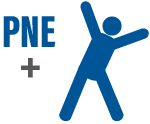Pain Therapy
Understanding Pain
In the United States, 126 million people have experienced an episode of pain in the past 3 months. Of those 126 million, over 50 million will continue to experience pain leading to limitations in their lives. This is referred to as chronic, or persistent, pain and can cause significant healthcare costs, estimated at 50 billion a year for low back pain. In fact, chronic pain continues to affect more people each year, with an estimated total cost of 600 billion dollars and rising.
 |
 |
 |
Pain can affect how we sleep, work, focus and manage our relationships on a daily basis. It affects both our stress level and how we manage anxiety. Whether we are aware of it or not, pain changes how our brain processes information and thus, can affect every aspect of our life. Given the prevalence of acute and chronic pain in the U.S., people are desperate to find a solution and often turn to opioids.
Opioids can provide instant relief but do not treat pain. Opioids are highly addictive and often times misused and abused. 80% of the global opioid supply and 99% of the global hydrocodone supply is consumed by the U.S*. Physical therapy can treat pain by identifying the underlying root cause of injuries or pain. Physical therapy is one of the best healthcare choices you can make because it is a safe, affordable and effective way to manage your pain while providing long-lasting health benefits.
At Athletico, our team is trained in pain neuroscience education. We can help you understand your pain and effectively manage your symptoms so you can return to your daily activities.
Pain Neuroscience Education: What is it?
Pain neuroscience education helps provide insight into the biology and physiology of the pain experience. It helps educate the patient on how and why pain is felt by better understanding the multiple factors involved in the process.
The nervous system acts as an alarm system within our body. When we experience something, it activates our nerve fibers to send messages to the brain. The brain then evaluates the symptoms and identifies if we have been to this environment before. If the brain associates that symptom with something that we’ve experienced before, it will activate additional pain. Pain is an output that the brain has designed to protect you. It is not something that comes from the tissues of your body. People can experience pain without symptoms. Because of this, we want to educate our patients about pain, as pain is interpreted differently among each of us.
How effective is Pain Neuroscience Education?
Understanding pain combined with movement and exercise from our therapists can be highly effective in your recovery. Our team of specialists will use metaphors, examples, pictures and books to educate our patients on their body and the pain they are experiencing.

Delivered primarily by physical therapists as verbal one-on-one education with the use of metaphors, examples, pictures and books |

Typically delivered in fifteen to thirty minute sessions once or twice a week for four to six weeks. |

PNE combined with movement and exercise is superior to education alone in decreasing pain and disability. |
To learn more about your pain and how to treat it, contact our Pain Therapy Specialists near you.
Find a Pain Therapy Specialist Near You
* Source: Manchikanti L, Singh A. “Therapeutic opioids: A ten-year perspective on the complexities and complications of the escalating use, abuse, and nonmedical use of opioids. Pain Physician. 2008; Opioid special issue: 11:S63-S88.